2012 VOLKSWAGEN GOLF service
[x] Cancel search: servicePage 228 of 516
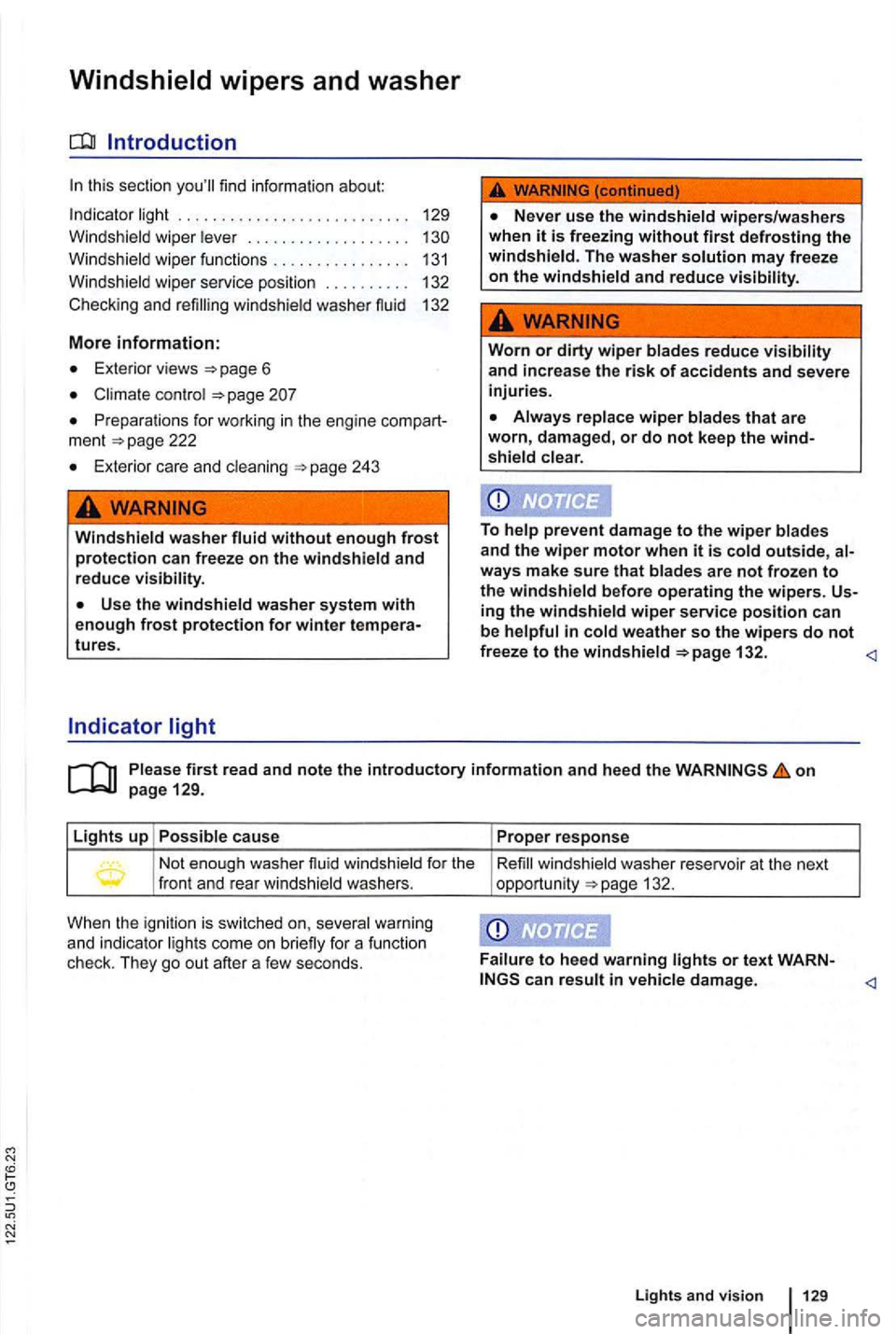
find information about:
Indicator light . . . . . . . . . . . . . . . . . . . . . . . . . . .
129
W indshield wiper lever . . . . . . . . . . . . . . . . . . .
Windshield wiper funct ions ................ 131
Windshiel d wiper service position . . . . . . . . . . 132
Checking and
Exterior views 6
Climate control
Preparations for working in the engine compart
ment page 222
Exterior care and cleani ng
Windshield washer fluid without enough frost protection can freeze on the windshield and reduce
..
Worn or dirty wiper blades reduce
132.
windshield washer reservoir at the next
opportun ity 132 .
Failure to heed warning lights or text WARNcan result in vehicle damage .
Light s and vision
129
Page 229 of 516
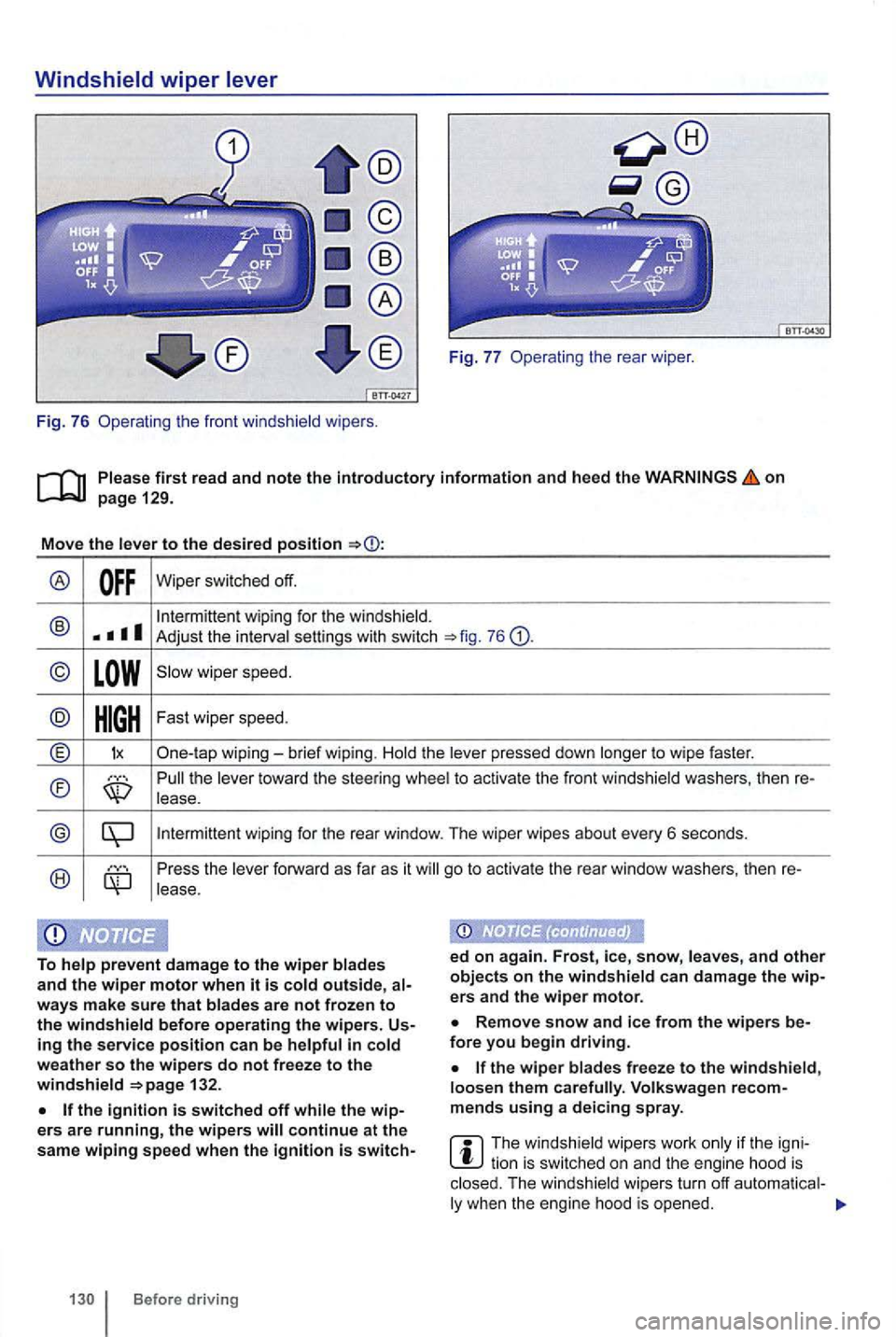
on
to the desired position
® Wiper switched off.
wiping for the windshield. ® Adjust the settings with switch 76
© wiper speed.
the pressed down to wipe faster.
® toward the steering to activate the front windshield washers, then re-
Intermittent wiping for the rear window . The wipe r wipes about every 6 seconds .
Press the forward as far as it
To prevent damage to the wiper outside, ways make sure that before ope rating the wipers. ing the service position can be weather so the wipers do not fre eze to the 132 .
the ignition is switched off the continue at the same wiping speed when the ignition is switch-
Remove snow and ice from the wipers fore you b egin driving.
the wiper
mends using a deicing spray.
if the lion is sw itched on and the engi ne hood is The
Page 231 of 516
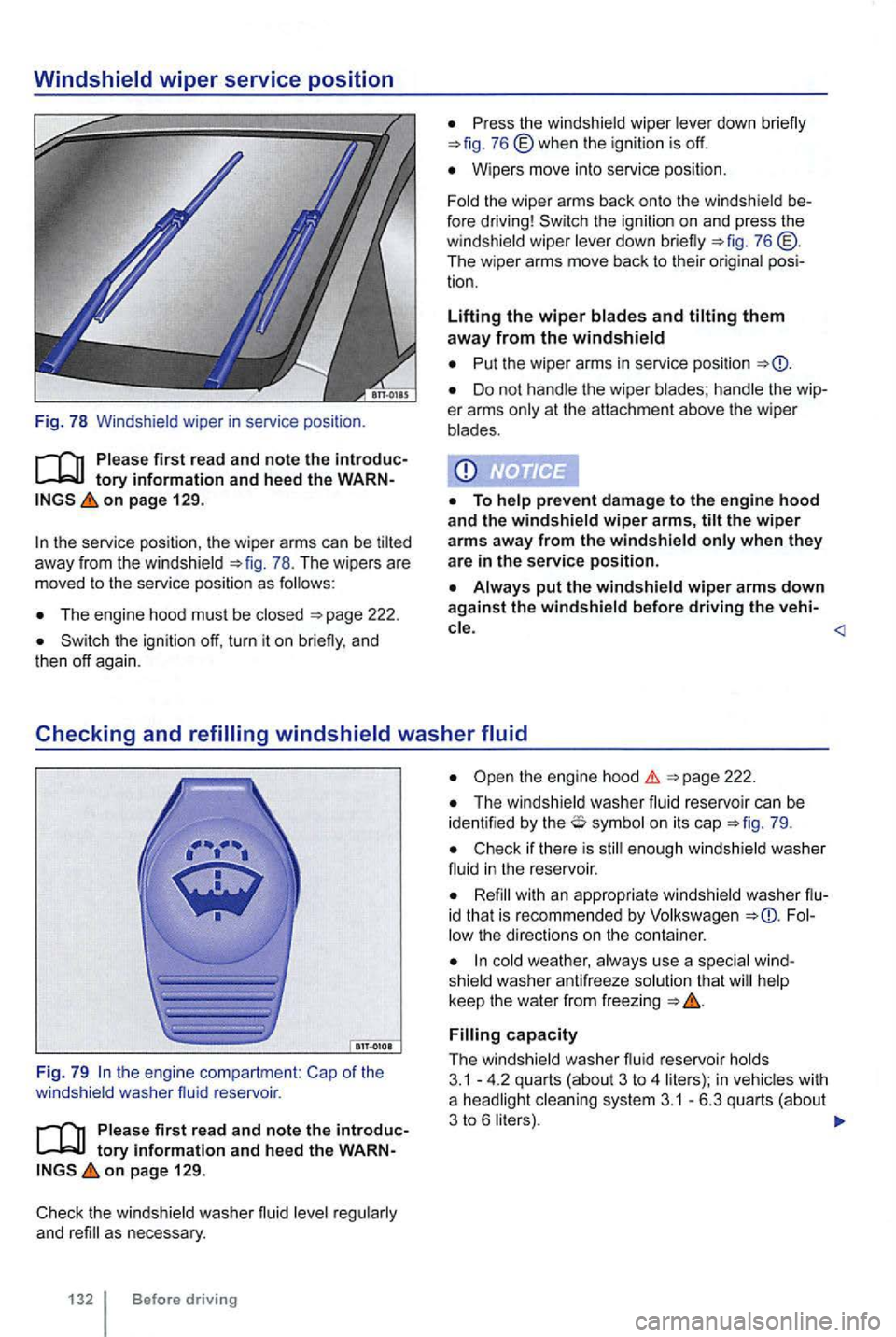
Windshield wiper service position
Fig. 78
first re ad and no te the introduc
on page 129.
away from the
Press the wiper down briefly 76 @ when the ign ition is off.
Wipers move into service position.
be
fore driving! Switch the ignition on and press the
down briefly position.
Lifting the wipe r blades and tilting them a w ay from the windshield
Put the wiper arms in service position
Do not the wiper the wip
er arms
To pre ven t da mage to the e ngine hood
and the winds hi eld wiper arms, o nl y when th ey
a re in the service position.
put the wipe r arm s down ag ai nst the
washer fluid reservoir .
first r ea d an d note the intro duc
on p age 12 9.
the
the engine hood 222.
The washer 79.
if there is was her
with an appropriate
weather, use a that
capacity
T h e washer reservoir
Page 250 of 516

An improperly or incorrect trailer hitch can cause a trailer to separate from the tow vehicle and cause serious personal ries.
you don't have to tow a trailer any more, remove the entire trailer hitch. Always seal bolt holes to prevent water and deadly haust fum es from getting into the vehicle .
the trailer lights are not connected ly, the ve hicle 's ele ctronics may be damaged .
Hitching up and connecting a trailer
on page 149.
Safety chains
Always make sure t hat the safe ty c hai ns a re er ly attac hed to the tow ing ve hic le. Leave enough
s lack in the chain s so th a t yo u ca n go aroun d ners witho ut stre tc hin g the c hai ns. Th e safe ty
c h ai ns must not drag on the groun d, h owever .
Trailer
mum power consumptio n for th e traile r
connections to the vehicle electrical system can cause malfunctions that affect the entire vehicle electrical system, which can lead to accide nts and se rious personal injury.
Loading the trailer
tory information and heed the WARN -on page 149.
the trail er uses too much electricity, the vehicle's electronics may be damaged.
Never connect the electrical system for the trailer directly to the electrical connections for the rear lights or to any other unsuitable power sources. Us e only a suitable connector to vide power to the trailer.
if you tow a trailer freq uently, recom mends havi ng t he vehicle serviced
tervals because of the extr a load it has to pu ll.
some countries an addit ional fire guisher must be carried if the tota l weig ht of
the traile r excee ds 5 ,5 12 lbs. kg ).
Never attach a
trailer to the vehicle or leave it attached to the vehicle when the trailer is
things (such as a change in trailer or vehicle
load or a fla t tire ) can lower or raise the vehicle. This subjects the trailer hitch and the trailer to strong forces that can damage the ve h icle or the trailer.
the engin e is swi tc h ed off and accessories in the tr ailer are o n and use elec tricity from
the vehicl e, th e ve hicl e battery be drained as
l o ng as t he e lec trical sys te m s o f th e an d
the t railer are c onn ecte d .
Page 252 of 516
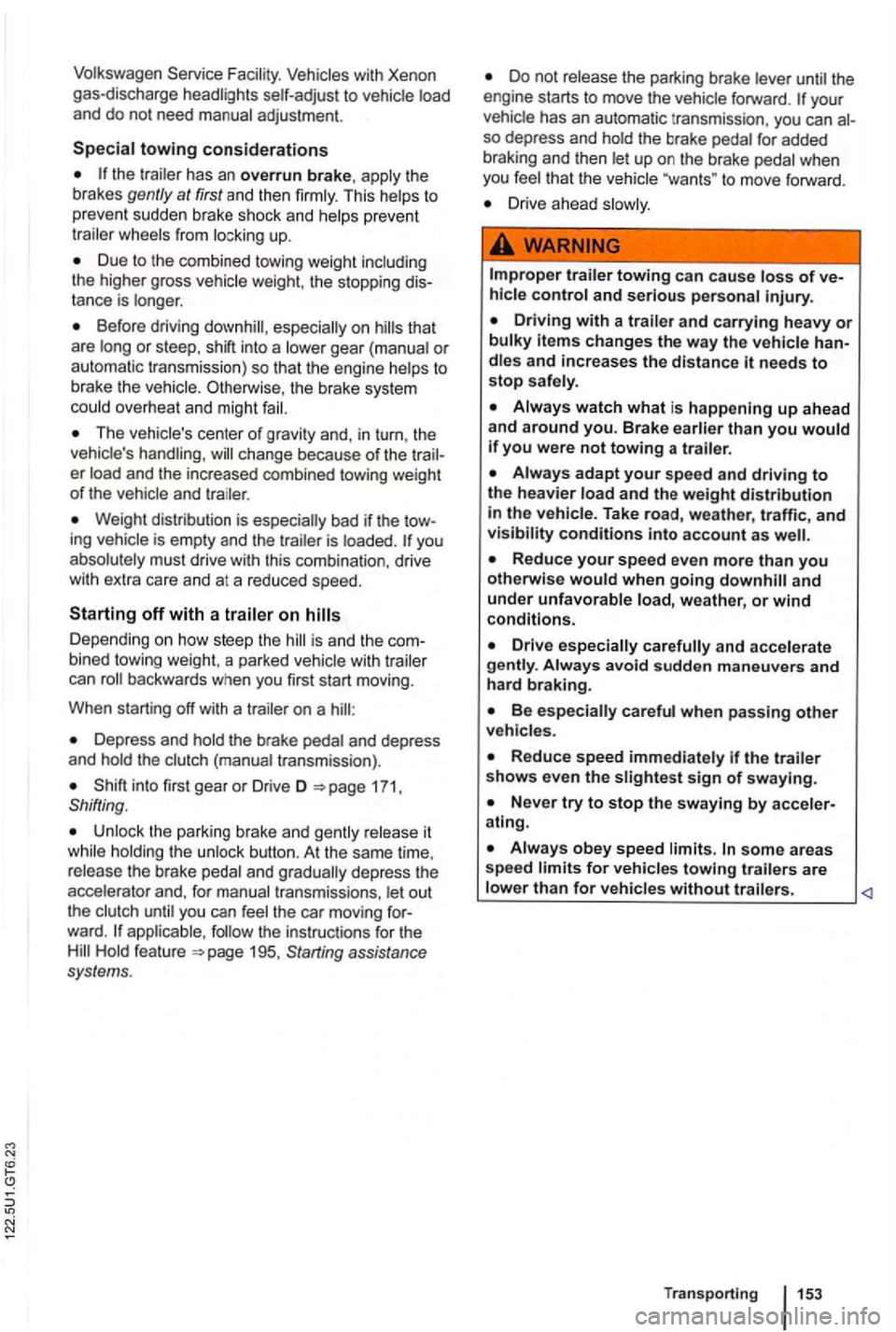
Volkswagen Service Vehicles with Xenon
gas-discharge self-adjust to vehicle load
and do not need manual adjustment.
Special towing considerations
th e t railer has an overrun brake, apply the
br akes
Due to the combined towing weight including
the higher gross vehicle weight, the stopping
tance is longer.
Be fo re drivi ng especially on
The vehicle's center of grav ity and , in turn, the
Weight distribution is especially bad if the is emp ty and the trailer is loaded.
Depending on how steep the is an d the
backwards when you first start moving.
When starting off with a tra iler on a
Depress and hold the brake pedal and depress
and hold the clutch (manu al transmission).
171, Shifting .
Unlock the parking brake a nd gently release it
whi le holding the unlock button. At the same time,
release the brake pedal and
depress the
accelerator and, for manual transmissions , let out
the clutch
you can feel the car moving ward . applicable, follow the instruct ions for the Hold feat ure
Do not release the parking brake lever until the
engine starts to move the vehicle forward. your
vehicle has an automatic tr ansmission , you can
so depress and hold the brake peda l for added
b raking and then Jet up on the brake pedal when
you feel that the to move forward .
Drive ahead slowly.
hicle contro l and serious per sonal injury.
dles and increases the distance it needs to stop safely .
Always adapt your sp ee d and driving to th e heavier loa d and the weight distribution in the vehicle. Tak e road , weather , traffic, and visibility conditions into account as well .
Always avoid sudde n maneuv ers and ha rd braking.
atin g.
som e areas
s p ee d for vehicles towing trailers are
lower than for vehicles without trailers.
Page 280 of 516
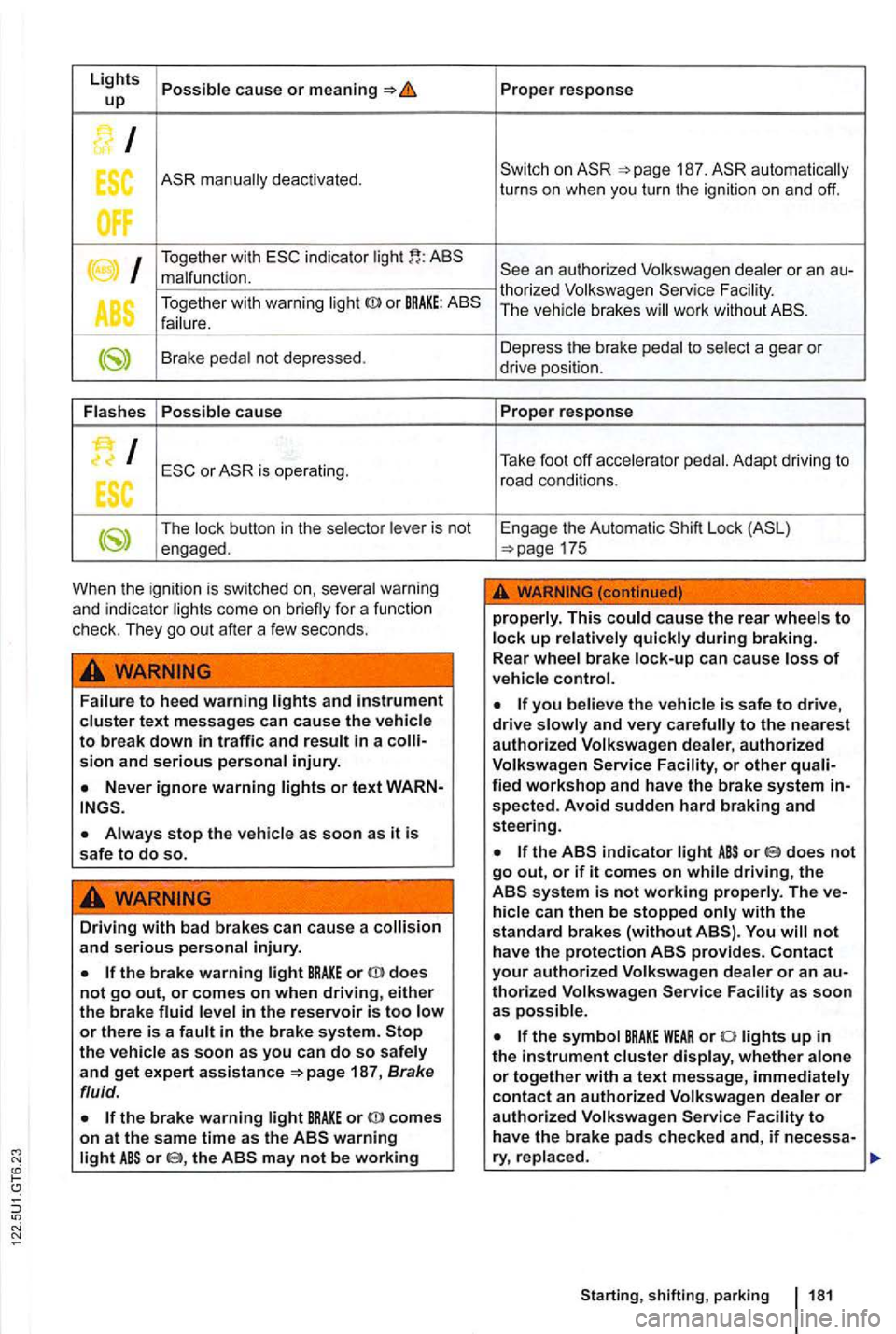
Lights cause or up
I
ES deactivated.
I Together with indicator malfunction .
T ogethe r with warning
or BRAKE:
Brake not dep ressed.
cause
I
The butt on in the is not
engaged .
When the ign ition is switch ed on,
text messages can cause the to break down in traffic and
or text WARN
stop the as soon as it is safe to do so.
Driving with bad brakes can cause a and serious
the brake warning BRAKE or does not go out, or comes on when driving, either the brake or there is a the as soon as you can do so and get expert assistance 187, Brake
fluid.
the brake warning comes on at the same time as the or the
187 . automatically
turns on when you turn the ignition on and off.
an authorized Volkswagen or an thorized Volkswage n The brake s work without
to
Adapt driving to
road conditions.
E ngage the Automatic
Lock
This up brake
you is safe to drive, drive and very authorized Volkswagen Service or other
spected. Avoid sudden hard braking and steering.
or does not go out, or if it comes on while driving, the system is not working can then be stopped with the
s tandard brakes (without not have the protection
thorized Volkswagen Service as soon as
Starting, shifting, parki ng 181
Page 283 of 516
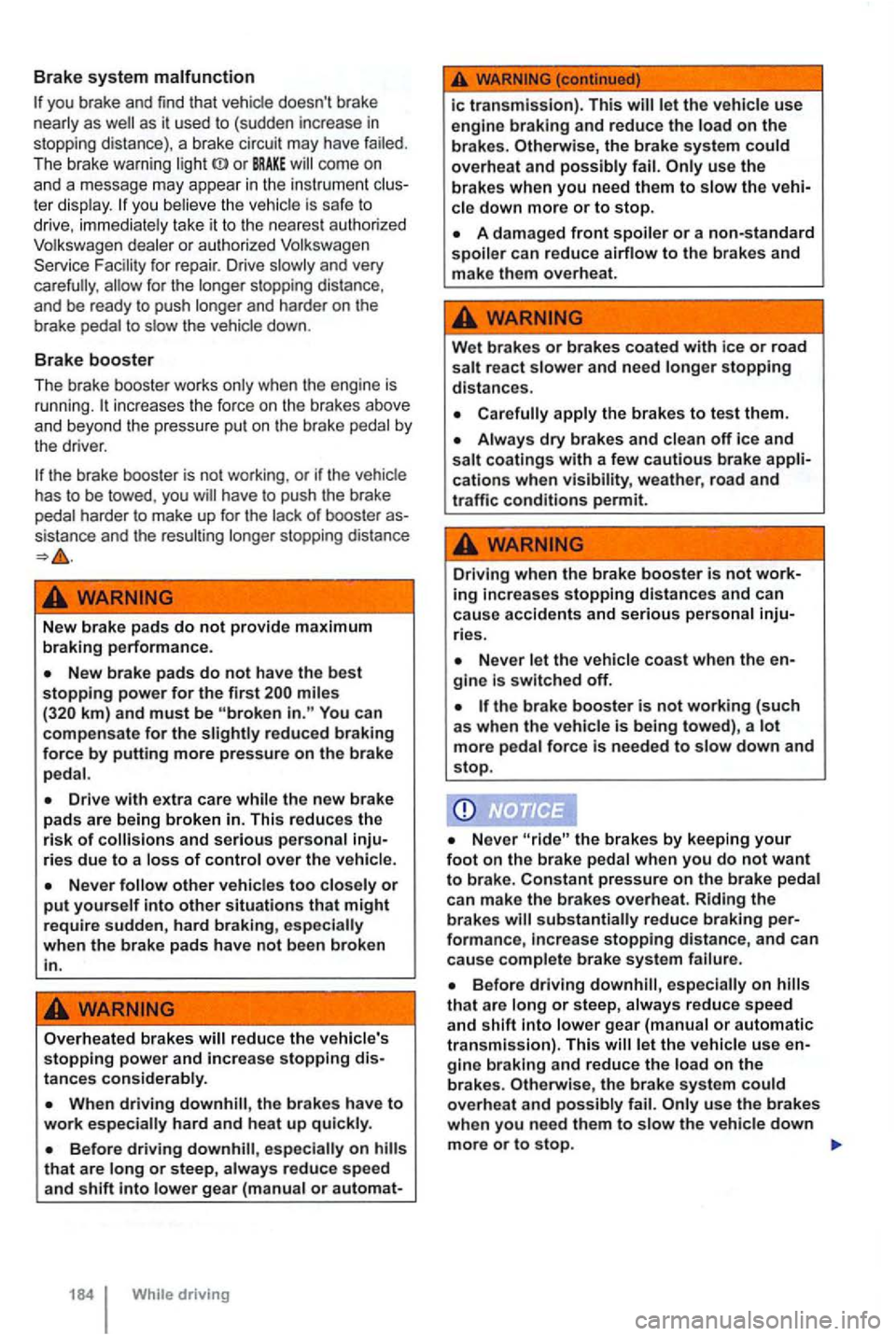
Brake system malfunction
you brake and find that vehicle doesn't brake
nearly as
come on
and a m essage may appear in the instrument ter display. you believe the vehic le is safe to
d rive, immediately take it to the nearest authorized
Volkswagen dealer or authorized Volkswagen
Service
f or repair. Drive slowly and very
carefully , for the longer stopping distance ,
and be ready to push longer and harder on the
brake pedal to slow the vehicle down.
Brake booster
The brake booster works only when the engine is
running . in creases the force on the brakes above
and beyond the pressure put on the brake pedal by
the driver .
New brake pad s do not provide maximum braking performance.
miles You can
compensate for the reduc ed braking force by putting more pressure on the brake
pedal.
other vehicles too closel y or put yourself into other situations that might require sudden, hard braking , especially
when the brake pads have not b ee n broken
in.
Overh eated brakes reduce the vehicle's stopping power and increa se stopping distances considerably.
that are long or s teep, always reduce speed
and shift into lower gear (manual or automat-
184 While driving
ic transmission). This let the vehicle use
engine braking and reduce the load on the brakes. Otherwise, the brake system could overheat and possibly fail.
A damaged front spoiler or a non-standard spoiler can redu ce airflow to th e brakes and make them overheat.
Wet brakes or brakes coated with ice or road
salt react slower and need longer stopping distances.
apply the brakes to tes t them .
Driving when the brake booster is not working increases stopping distances and can
cause accidents and serious per sonal inju
rie s.
Nev er let the vehicle coas t when the
the bra ke booster is not working (suc h
a s wh en th e vehic le is being towed) , a lot more pedal force is needed to slow down and stop.
Neve r the brake s by keeping your foot on the brak e pedal when you do not want to brak e. Constant pres sure on the brake ped al
ca n make the brak es overheat. Riding the bra kes substantially r educe brakin g performance, increase stopping distance, and can
cause complete brake system failure .
that are long or s teep, always reduce speed and shift into lower gear (manua l or automatic tran smission). This gine brakin g and reduce the load on t he brakes. Otherwise, the brake system cou ld
o ve rheat and possibly fail. use the brakes when you n eed them to slow the vehicle down more or to stop.
Page 284 of 516

When th e front brakes are serviced , you
checked The best way to check for brake pad wear is to have your author-
Braking assistance systems
first read and note the introductory information and heed the WARNon pag e 179.
The and EDL braking assistance systems work
to improve road dynamics to of skidding and of when the engine is running . driving situations ,
you to get the
the
has of physics. not
may not be
or snow,
(r ides on a cushion of water instead of the road surface) , not be because contact with the pavement has been interrupted and the
as with difficult driving situations as it can at speeds. When towing a to if you were not towing a
to visiroad, traffic , and weather conditions . cannot override the in crease the trac tion , o r keep a
of keeping the and on the road ized
inspect the pads through the openings in the necessary, the can be taken
off for a more thorough inspection.
extreme maneuvers by using the driver's
s teeri ng inputs to
can provide any assistance, you may not experience the benefits of
and/or works together wi th the EDL, and XDL systems (see the time and cannot be switched off. certain situations when you need traction cannot be achieved, you can switch off by pressing the button on again when you no traction .
Anti-Lock Brake
to keep the to maintain the driver's to steer and the This means the is
down hard and
Do not "pump" the brake
the
notice a
cannot shorten the stopping distance
under all conditions. The stopping distance may even be for instance , when driving on gravor on snow covering an icy or pery surface.
Brake Assis t
can you press the brake very detects an emergency situation. brake system pres
sure , maximizing braking power and reducing the stopping distance. This way, and efficiently.